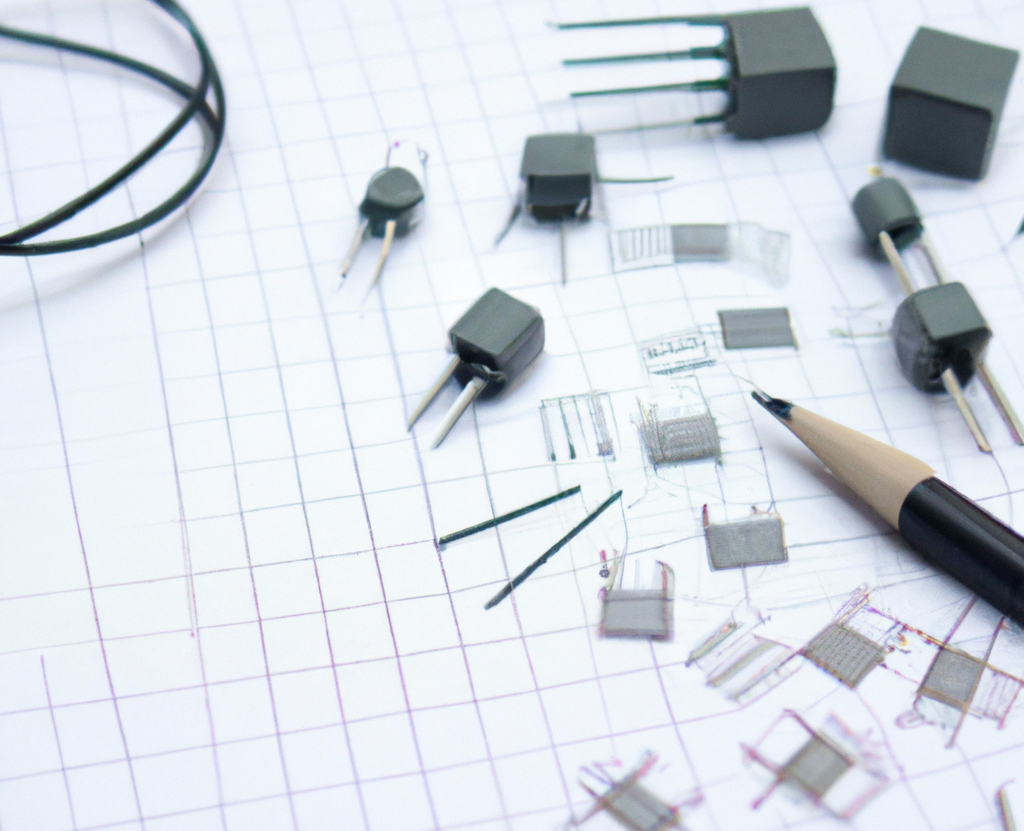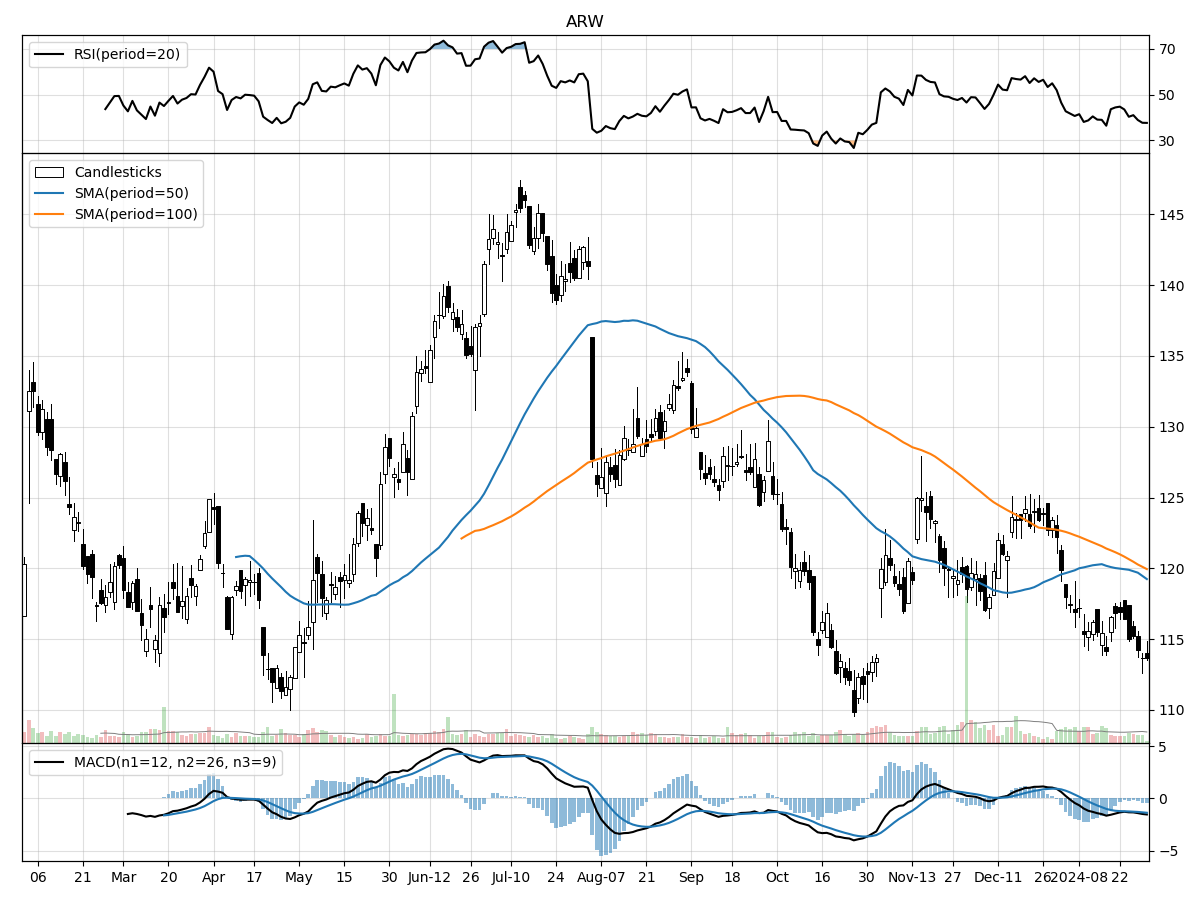Arrow Electronics, Inc. (ARW), Mid/Small Cap AI Study of the Week
Arrow Electronics, Inc., founded in 1946, is a major global distributor of electronic components and enterprise computing solutions

February 1, 2024
Weekly AI Pick from the S&P 400 or S&P 600
Company Overview
Arrow Electronics, Inc., founded in 1946, is a major global distributor of electronic components and enterprise computing solutions, operating through two primary segments: Global Components and Global Enterprise Computing Solutions (ECS). The Global Components segment, which generates 78% of the company's sales, provides design, marketing, and supply chain services, mainly for semiconductors and related products. The ECS segment, accounting for 22% of sales, offers value-added IT solutions and services. In 2022, the ECS segment expanded its cloud services with ArrowSphere, a platform that supports VARs and MSPs.
Arrow serves a diverse customer base with no single customer accounting for more than 2% of sales. However, one supplier represents 13% of sales, and Arrow has distributor agreements in place that often protect against inventory devaluation. The company's financial strategy aims to outpace market growth and accelerate profits, with a focus on strategic acquisitions and capital allocation to enhance returns on invested capital. Arrow also has measures in place to protect against product obsolescence and price erosion, which cover about 54% of its inventory.
Competition in Arrow's market is intense, with competitors of varying sizes across different sectors and geographies, and the company even competes with its suppliers at times. Arrow follows strict adherence to global government regulations, which could affect operations through increased costs, taxes, or penalties. With approximately 22,300 employees worldwide, Arrow emphasizes human capital, focusing on diversity, talent development, and a pay-for-performance philosophy to foster a skilled workforce. The company offers competitive compensation and benefits to attract and retain talent and has remained resilient through the COVID-19 pandemic by maintaining safe working conditions.
Arrow's executive team, led by CEO Sean J. Kerins and Executive Chairman Michael J. Long, brings substantial industry experience to the company. For more detailed information about Arrow's operations and financials, interested parties can refer to the company's filings with the SEC, available on the SEC's website or Arrow's Investor Relations website. Additional human capital information is provided in Arrow's ESG Report, which is separate from their Annual Report on Form 10-K.
By the Numbers
Annual 10-K Report for 2022:
- Consolidated sales: $37,124 million (up 7.7% from $34,477 million in 2021)
- Gross profit: $4,837 million (up 15.1% from 2021)
- Gross profit margin: 13.0% of sales
- Operating expenses: $2,768 million (up 4.6% from 2021)
- Operating income: $2,068 million (up 32.9% from 2021)
- Non-GAAP operating income: $2,117 million (up 31.6% from 2021)
- Net income attributable to shareholders: $1,427 million (up from $1,108 million in 2021)
- Working capital increase: $1,473 million
- Cash and cash equivalents: $177 million (down from previous year)
- Undrawn liquidity: over $2.1 billion
- Net cash provided by operating activities: -$33 million (negative, down from previous year)
- Net cash used for investing activities: $57.7 million
- Net cash provided by financing activities: $109.8 million
- Capital expenditures: $78.8 million
- Share repurchase authorization: $1.6 billion for future repurchases
Quarterly 10-Q Report for Q3 2023:
- Consolidated sales: Decreased by 13.6% for the quarter and 9.1% for the first nine months (year-over-year comparison not provided)
- Net income attributable to shareholders: $198.7 million for the quarter, $709.0 million for the first nine months (down from $342.4 million and $1.1 billion in the previous year, respectively)
- Operating expenses: Decreased by 6.5% for the quarter and 3.8% for the nine months
- Operating income: Decreased by 32.3% for the quarter and 25.3% for the nine months
- Non-GAAP operating income: Decreased (specific percentage not provided)
- Global components segment operating income: Decreased by 23.4% for the quarter and 22.4% for the nine months
- Global ECS segment operating income: Decreased by 35% for the quarter and 12.5% for the nine months
- Investment losses: Reported for the quarter (specific figures not provided)
- Net interest and other financing expenses: Increased significantly (specific figures not provided)
- Effective income tax rate: 20.7% for the quarter, 22.0% for the nine months
- Liquidity: Over $1.9 billion undrawn, $333.3 million in cash as of September 30, 2023
- Working capital: $7.378 billion
- Long-term debt: $2.615 billion
- Cash flow from operations: $418.7 million for the first nine months of 2023
- Capital expenditures: $57.8 million
- Share repurchase program: Expanded by $1.0 billion, with $621.6 million remaining as of September 30, 2023
These figures provide a snapshot of ARW's financial health and performance, indicating robust growth in the annual report but a notable downturn in the quarterly report.
Stock Performance and Technical Analysis

As a stock analyst, it's important to dissect the technical indicators to understand the potential direction of a stock's price movement. The current stock price being 3 percent above its 52-week low and 22 percent below its 52-week high suggests that the stock has recently been through a downtrend but has not reached new lows. This could indicate that there's a potential support level nearby, preventing the stock from dropping further, but the considerable distance from the 52-week high also shows that the stock has room for recovery if the market sentiment shifts positively.
The recent daily volume slightly exceeds the longer-term average, indicating a moderate increase in trading activity. This can sometimes be a precursor to a trend reversal, but it's not a strong enough signal on its own. The decline in price over the last month and three months could be seen as a bearish trend, but without additional context, it's not clear whether this is a temporary pullback or the start of a longer-term downtrend.
The Money Flow indicators suggest that there is moderate selling pressure and the stock is under distribution, meaning that more investors are looking to sell their shares than buy. This could lead to a bearish outlook in the short term. The MACD (Moving Average Convergence Divergence) being bearish and at -1.36 reinforces this negative sentiment, as it indicates that the short-term momentum is weaker than the long-term momentum, and the stock could continue to decline. Investors should watch for a potential MACD crossover from negative to positive as a signal of a potential trend reversal.
Given these indicators, the stock appears to be currently facing downward pressure. A prudent approach would be to wait for more bullish signals before considering an entry, such as a positive MACD crossover, an increase in daily volume with price upticks, or other signs of reversal like a bullish candlestick pattern at a key support level. It's also essential to consider the broader market conditions and any company-specific news or events that could influence the stock's price.

The ‘Bull’ Perspective
Title: Arrow Electronics, Inc. (ARW): A Bullish Investment Thesis Amidst Economic Recovery
Upfront Summary:
- Resilient Performance: Despite a challenging economic backdrop, Arrow Electronics has demonstrated resilience, with a robust liquidity position of over $1.9 billion undrawn and $333.3 million in cash as of September 30, 2023.
- Strategic Cost Management: Arrow's operating expenses decreased by 6.5% for the quarter and 3.8% for the nine months, showcasing effective cost control measures in response to market conditions.
- Strong Cash Flow Generation: The company's cash flow from operations was $418.7 million for the first nine months of 2023, indicating a strong ability to generate cash.
- Shareholder Value Focus: ARW's commitment to returning value to shareholders is evident through its share repurchase program, with $621.6 million remaining for future buybacks as of September 30, 2023.
- Market Conditions and Economic Indicators: Positive economic indicators, such as the U.S. S&P manufacturing PMI reaching 50.3 in January, the highest since October 2022, and moderating inflation, paint a favorable backdrop for Arrow's business.
Elaboration on Key Points:
- Resilient Performance:
Arrow Electronics' resilience in the face of economic downturns is commendable. With over $1.9 billion in undrawn liquidity and $333.3 million in cash reserves, the company is well-positioned to navigate market volatility. This robust financial position is a testament to ARW’s prudent financial management and strategic planning. The company's ability to maintain such a strong liquidity profile, despite a decrease in consolidated sales of 13.6% for the quarter, shows its operational efficiency and conservative approach to balance sheet management. - Strategic Cost Management:
In an environment where many firms are struggling to manage expenses, Arrow Electronics has effectively reduced its operating expenses significantly. This reduction is a strategic move that reflects the company's agility in adjusting to market dynamics. By lowering variable costs and benefiting from a $62.2 million legal settlement gain, ARW is protecting its margins and ensuring that it remains competitive in the market. This focus on cost management is crucial, especially when sales are under pressure, and is a clear indicator of the company's strong operational discipline. - Strong Cash Flow Generation:
Arrow's cash flow from operations, standing at $418.7 million for the first nine months of 2023, is a solid indicator of the company's financial health. This strong cash flow generation underscores ARW’s ability to convert its business activities into cash effectively, which is vital for sustaining operations, investing in growth opportunities, and returning capital to shareholders. In a sector where cash is king, Arrow’s performance in this area signals a robust underlying business. - Shareholder Value Focus:
Arrow's ongoing share repurchase program, with $621.6 million earmarked for future buybacks, reflects a clear strategy to enhance shareholder value. This move not only signals confidence in the company's intrinsic value but also serves to support the stock price by reducing the number of shares outstanding. In an era where shareholder return is paramount, ARW's commitment to buybacks is a positive sign for investors looking for companies with a shareholder-friendly capital allocation policy. - Market Conditions and Economic Indicators:
The broader economic environment is showing signs of improvement, with key indicators like the manufacturing PMI signaling expansion and core PCE inflation moderating to 2.9% year-over-year. These conditions bode well for Arrow Electronics, as a robust economy typically translates to increased demand for electronic components and enterprise computing solutions. Furthermore, with the Federal Reserve expected to start reducing policy rates, the cost of borrowing may decrease, potentially lowering Arrow's interest expenses and boosting profitability.
In conclusion, Arrow Electronics presents a compelling investment opportunity, combining financial resilience, strategic cost management, strong cash flow generation, a focus on shareholder value, and a favorable economic backdrop. While risks related to supply chain disruptions, competitive pressures, and geopolitical uncertainties persist, ARW's robust fundamentals and proactive management strategies position it well to capitalize on market opportunities and deliver long-term value to investors.

The ‘Bear’ Perspective
Bearish Outlook on Arrow Electronics, Inc. (ARW): A Cautionary Perspective
Summary:
- Declining Sales and Profits: Arrow Electronics has reported a 13.6% decrease in consolidated sales year-over-year for the third quarter and a significant drop in net income from $342.4 million to $198.7 million for the same period.
- Vulnerable Supply Chain: The company's reliance on a limited number of suppliers and the recent supply chain disruptions have led to shortages and increased costs, jeopardizing profitability.
- Rising Operating Expenses: Despite a decrease in operating expenses, Arrow faces ongoing challenges with environmental liabilities, restructuring costs, and increased credit loss charges.
- Economic and Regulatory Risks: Fluctuating currency exchange rates, geopolitical tensions, and stringent regulations present substantial risks to Arrow's international operations and financial outcomes.
- Market and Technological Pressures: Rapid technological changes and intense competition threaten Arrow's market position and inventory value, while the company's growth through acquisitions introduces integration risks.
Elaboration:
- Financial Performance Concerns
Arrow Electronics' recent financial results raise red flags for potential investors. The 13.6% decline in sales for Q3 2023, coupled with a sharp decrease in net income, reflects underlying business challenges. The company's performance is further marred by a 9.1% decrease in sales for the first nine months of 2023 compared to the previous year. These numbers indicate a worrying trend, suggesting that the company may be losing ground in a competitive market. The significant reduction in net income, almost halving from the previous year's quarter, is a stark indicator of profitability issues that cannot be ignored. - Supply Chain Vulnerabilities
Arrow's heavy reliance on a few key suppliers and the recent global supply chain disruptions pose a significant threat to its operational efficiency. The company's largest supplier accounted for a substantial 13% of its 2022 sales, which means any disruption with this supplier could have a considerable impact on Arrow's business. The COVID-19 pandemic has already demonstrated how fragile the global supply chain can be, with shortages and price surges affecting numerous industries, including electronics distribution. - Operational and Restructuring Costs
While Arrow Electronics has managed to reduce its operating expenses by 6.5% for the quarter, the company is not immune to rising costs associated with environmental liabilities, restructuring, and credit loss charges. These factors contribute to a decrease in operating income by 32.3% for the quarter. Such financial pressures can erode profit margins and hinder the company's ability to invest in growth and innovation, ultimately affecting its competitive edge. - Economic and Regulatory Uncertainties
The company's international presence exposes it to currency exchange rate volatility, which can unpredictably affect profit margins. Geopolitical risks, such as the ongoing conflict between Ukraine and Russia, introduce additional uncertainty and potential trade disruptions. Furthermore, the threat of regulatory changes, including tariffs and export controls, could lead to increased operational costs and compliance challenges, impacting Arrow's bottom line. - Technological and Competitive Challenges
In an industry characterized by rapid technological evolution, Arrow Electronics must continuously adapt to maintain its market position. The risk of inventory obsolescence is high, as products can quickly become outdated. Moreover, the company's strategy of growth through acquisitions carries the risk of integration issues and unexpected liabilities. As competitors leverage new technologies and innovations, Arrow must invest heavily to stay relevant, a strategy that may not always yield the desired returns given the current financial setbacks.
In conclusion, while Arrow Electronics, Inc. has been a significant player in the distribution of electronic components and computing solutions, the company currently faces a multitude of challenges that cast doubt on its investment potential. The combination of declining sales, supply chain vulnerabilities, rising costs, economic and regulatory uncertainties, and technological pressures creates a precarious situation for Arrow. Investors should exercise caution and consider these factors carefully before making any investment decisions regarding ARW stock.




Comments ()